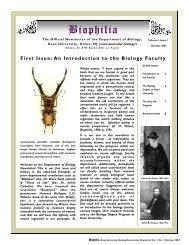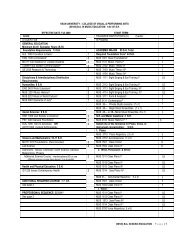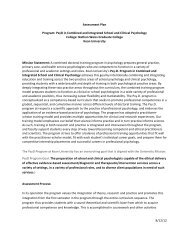Embodying the Sacred in Yoruba Art - Kean University
Embodying the Sacred in Yoruba Art - Kean University
Embodying the Sacred in Yoruba Art - Kean University
You also want an ePaper? Increase the reach of your titles
YUMPU automatically turns print PDFs into web optimized ePapers that Google loves.
18<br />
staffs called òpá Òsanyìn (pl.15). Measur<strong>in</strong>g between eighteen and fifty<br />
<strong>in</strong>ches <strong>in</strong> height, a typical staff features a circle of small birds and a shaft<br />
<strong>in</strong> <strong>the</strong> middle that elevates a large bird above <strong>the</strong> smaller ones, as though<br />
relay<strong>in</strong>g metaphysical powers from <strong>the</strong> celestial to <strong>the</strong> terrestrial realm.<br />
The position of <strong>the</strong> top bird echoes <strong>in</strong> <strong>the</strong> frequent reference to Òsanyìn<br />
as “<strong>the</strong> one who sees everyth<strong>in</strong>g like Olódùmarè,” thus plac<strong>in</strong>g this òrìsà<br />
<strong>in</strong> a position to protect humanity from negative forces, especially diseases.<br />
The apical bird <strong>in</strong> plate 16 has been transformed <strong>in</strong>to a mounted wear<strong>in</strong>g<br />
a crownlike headgear and hold<strong>in</strong>g what looks like a fan. Called abèbè, a fan<br />
connotes “coolness” <strong>in</strong> <strong>Yoruba</strong> thought, thus allud<strong>in</strong>g to <strong>the</strong> use of herbs for<br />
curative purposes. Surround<strong>in</strong>g <strong>the</strong> pr<strong>in</strong>cipal figure are smaller ones, and<br />
below <strong>the</strong>m is a flock of birds, all seem<strong>in</strong>gly engaged <strong>in</strong> cosmic surveillance.<br />
Òrìsà Oko: <strong>the</strong> Agriculture Deity<br />
The sheaths <strong>in</strong> plates 17 and 18 are used to adorn or “dress” <strong>the</strong> wroughtiron<br />
staffs for Òrìsà Oko, <strong>the</strong> agriculture deity. 15 Some sheaths have beaded<br />
or cowrie-embroidered caps16 to ornament <strong>the</strong> phalluslike end of <strong>the</strong> staff,<br />
<strong>the</strong>reby allud<strong>in</strong>g not only to <strong>the</strong> wealth that farm<strong>in</strong>g can generate but also to<br />
support <strong>the</strong> legend that Òrìsà Oko was one of <strong>the</strong> ancient k<strong>in</strong>gs of <strong>the</strong> town<br />
of Ìràwò.<br />
Sàngó: <strong>the</strong> Thunderstorm Deity<br />
The altar bowl (igbá Sàngó) <strong>in</strong> plate 11 is for hold<strong>in</strong>g Neolithic stones<br />
(edùn àrá) that are believed to have been hurled down from <strong>the</strong> sky by<br />
Sàngó dur<strong>in</strong>g thunderstorms. The stylized face (ojú), as noted above,<br />
enables a worshiper to have direct communion with <strong>the</strong> deity. Carved on<br />
<strong>the</strong> lid is a mounted warrior who seems to be fir<strong>in</strong>g a gun jubilantly <strong>in</strong>to<br />
<strong>the</strong> air dur<strong>in</strong>g what looks like a victory parade. The two musicians beh<strong>in</strong>d<br />
and below <strong>the</strong> warrior are play<strong>in</strong>g conical drums called bàtá, whose<br />
rhythm is sacred to Sàngó. The figure <strong>in</strong> plate 19 holds an identical drum.<br />
The emphasis on bàtá drummers <strong>in</strong> this composition suggests that <strong>the</strong>y<br />
are perform<strong>in</strong>g <strong>in</strong> a public ceremony dedicated to Sàngó, apparently <strong>in</strong><br />
gratitude for his spiritual support dur<strong>in</strong>g a recent battle. Located <strong>in</strong> front<br />
of <strong>the</strong> horse (above <strong>the</strong> stylized face on <strong>the</strong> bowl’s lid) is a palm-w<strong>in</strong>e<br />
tapper with a gourd tied to his waist — an <strong>in</strong>dication that <strong>the</strong>re will be<br />
plenty to dr<strong>in</strong>k on this important occasion.<br />
S<strong>in</strong>ce it signifies Sàngó’s firepower, <strong>the</strong> Neolithic stone (also called thunder-<br />
bolt) is often stylized sculpturally <strong>in</strong>to a double-axe ritual staff (osé-Sàngó)<br />
borne by a devotee. The double axe atop <strong>the</strong> kneel<strong>in</strong>g female <strong>in</strong> plate 20<br />
h<strong>in</strong>ts at <strong>the</strong> diety’s ability to punish wrong-doers and reward <strong>the</strong> righteous.<br />
In addition, it alludes to <strong>the</strong> <strong>in</strong>teraction of <strong>the</strong> male Sky and female Earth<br />
dur<strong>in</strong>g thunderstorms, which results <strong>in</strong> agricultural fecundity, among o<strong>the</strong>r<br />
th<strong>in</strong>gs. The female figure is flanked by two rams apparently <strong>in</strong>tended as<br />
offer<strong>in</strong>gs to Sàngó for his benevolence or <strong>in</strong> gratitude for a recent bless<strong>in</strong>g.

















